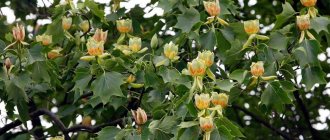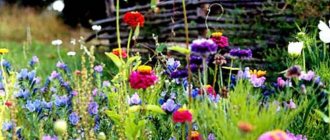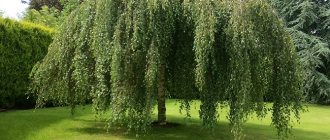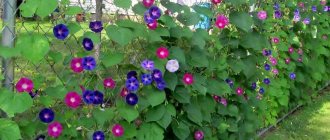As a rule, flowers are planted on the site so that they please the gardener's eye with an attractive appearance. But a fragrant summer garden is a real joy for any florist, summer resident and gardener. There are certain flowers with a bright and rich scent that can delight the gardener not only with their appearance, but also with a pleasant fragrant aroma. The selection will tell you about flowers that are fragrant during the day or at night. Thanks to planting such crops, you can enjoy a fragrant garden in the morning, afternoon, evening and night!
Advice! It is recommended to grow fragrant flowers near areas where you spend a lot of time while relaxing, for example, near a house, gazebo, summer kitchen, summer shower, along garden paths, next to a hammock.
Alyssum
Alyssum trims well and grows quickly, then blooms again, which makes it possible to make trimmed borders from tall varieties
Alyssum, also known as alyssum, delights flower growers with its unique aroma of honey. Both annual and perennial species of this plant can be grown in garden plots. They bloom throughout the summer.
Trimming flower stalks encourages re-blooming.
Buds on alyssum begin to appear 6–7 weeks after germination. As soon as the first flowers bloom, the garden begins to fill with the aroma of honey and mown grass. The smell is persistent and suffocatingly sweet, so it is recommended to plant it in open areas.
Alyssum can be grown in many regions of Russia. It is cold resistant. Alyssum is not afraid of even spring frosts; it easily tolerates sudden cold snaps. It is recommended to plant alyssum seedlings in the ground in central Russia in the last days of May. It thrives best in sunny garden areas with neutral, well-drained soil. Many people plant alyssum in compositions on alpine hills and in rocky gardens. It can grow between stones and slabs heated by the sun.
Flowers quickly grow in width, so when planting, experts advise leaving about 40 cm between bushes. After planting, abundant watering is required. Alyssum should not experience a lack of moisture, but if water stagnates, there is a possibility that the plant will disappear.
Alyssum is easy to care for. The main thing is to water the plant in a timely manner and apply fertilizer. When growing perennial species in the spring, be sure to trim off the remaining flower stalks, dry leaves, and weak shoots.
Alyssum is a permanent inhabitant of my garden, because it smells very pleasant and attracts bees and bumblebees to the area. This modest inhabitant may not seem beautiful to some, but I will tell you this: you don’t need to separate the plants in the flowerbed and then a real white cloud will grow from one alyssum root. Its main advantage is its unpretentiousness.
My name is Spring
https://irecommend.ru/content/belye-tsvety-i-medovyi-aromat-eto-alissum
Iberis
Iberis
Iberis has a modest appearance, but has an incredible aroma. The flowering of the plant lasts for a month. The most famous variety is bitter iberis, which has white inflorescences. The umbrella type of plant is also popular; it has lilac-pink flowers. This variety is also actively used for growing on loggias and balconies.
Mattiola
Planted together with potatoes, matthiola perfectly repels the Colorado potato beetle and other pests
Flower growers who choose plants based on pictures on packs often avoid matthiols. The unremarkable flowers, known to many as night violets, exude a unique spicy-sweet aroma in the evening. Knowledgeable people advise planting mattiolas near gazebos, benches, and under the windows of houses.
The plant blooms throughout the summer; even the first frosts are not scary for matthiolas. Each flower lives no more than 5 days. As soon as it fades, a pod-shaped fruit with 2 horns is formed in its place.
In Russia, night violet can be sown in open ground in mid-spring. Experienced flower growers advise dividing planting into several stages with a break of 12–17 days. Compliance with such intervals will ensure continuous flowering throughout the summer.
The plant is unpretentious; there is no need to create special conditions for matthiola. But for good flowering at your dacha it is advisable:
- monitor soil moisture;
- fertilize the soil during the period of bud formation;
- remove weeds, loosen the soil.
It is important to be careful when caring for matthiola. The stems of the plant are easily damaged.
This is a plant with a truly divine aroma. It blooms only at night and is incredibly pleasing to the eye. When you go out into the yard in the evening, you feel how it is filled with a charming light, fresh aroma, and you don’t want to go in! Matthiola blooms all night, and when it’s cloudy, it can bloom all day; apparently, the delicate petals do not like the sun’s rays.
Tatunya Manyunya
https://otzovik.com/review_2214753.html
Mignonette
Mignonette
Another fragrant flower is mignonette. The most famous varieties are “Victoria”, “Mashet”, “Ruby”, “Goliath”. Color: red-green, yellowish, dark brown, light green. Mignonette is planted in late April or early May. How mignonette sprouts depends on soil moisture and weather conditions. The first shoots are observed after 1-2 weeks. The culture prefers free space, so it must be thinned out. To grow plants, choose areas that receive good sunlight.
Sweet pea
Sweet pea has been known for a long time both in the West and in the East.
When choosing flowers for the garden, many people advise paying attention to sweet peas. Plants with purple flowers are considered the most fragrant; it is better to choose varieties that were bred a long time ago. New hybrids are visually attractive, but their smell is weaker. Sweet peas are ideal for growing in central Russia, as they grow best in cool weather.
Recent Entries
Chainsaw or electric saw - what to choose for the garden? 4 mistakes when growing tomatoes in pots that almost all housewives make Secrets of growing seedlings from the Japanese, who are very sensitive to the soil
The flowers have an intoxicating sweet aroma that can spread over long distances. This is a unique combination of the smell of meadow grass, honey, and flowers.
The flowering period lasts from June to November.
The seeds are sent to the soil after the snow melts. In closed ground they can be sown at the end of winter. To speed up the germination process, it is better to soak the seeds for 12 hours. After planting, it is recommended to mulch the soil. It will help preserve the plant during sudden night frosts. In summer, mulch is necessary to prevent the roots from overheating and the soil from drying out too quickly.
Features of cultivation:
- It is necessary to plant peas near nets and trellises so that the plant has the opportunity to climb;
- dried flowers need to be cut to stimulate the flowering process;
- The plants require regular watering; when there is drought, the buds fall off.
You can stimulate the process of active flowering if you add complex fertilizer to the soil 2-3 times a season.
I absolutely love the aroma of sweet peas on a summer evening after watering! Thanks to it, I not only enjoy the aroma, but also the old fence in the yard is being improved, which would be broken, but it would be a pity to unite the yard. Convenient zoned parts. The peas are not whimsical, docile, they like to grow tall, but I try to pinch them so that they bush better!
Pink
https://otzovik.com/review_4588149.html
Carnation
The Latin name – “flower of Zeus” – was given to the carnation for its beauty. And not from anyone, but from Carl Linnaeus himself, the man who developed the first classification of living organisms. However, gardeners love this flower not only for its rich palette and variety of forms, but also for its pleasant smell, which intensifies in the heat.
Cloves, which are used as a spice, have absolutely nothing to do with the garden crop of the same name. In the process of preparing dishes, cooks add dried buds of aromatic syzygium, which, despite its second name, clove tree, belongs to the Myrtaceae family. While the ornamental plant belongs to the Carnation family.
- What types of carnations are there - photos, descriptions of types, popular varieties
Types and varieties of garden carnations with detailed descriptions and photos.
Lily of the valley
In the Middle Ages, medicines for fever, epilepsy, and heart disease were prepared from the plant.
In many regions of Russia, lilies of the valley can be planted. These low-growing perennial flowers thrive in shaded areas. A subtle floral aroma with tart cool notes can be felt even at a distance.
When planting lilies of the valley, you must remember that every year the rhizomes grow by 15–25 cm. The plant grows well and can even displace other flowers from the area. Therefore, experienced gardeners advise planting them in separate areas. Lily of the valley meadows bloom in May - June.
For abundant flowering you need:
- When planting lilies of the valley, avoid swampy soils; the plant thrives in moist, loamy soils with a low acidity level;
- maintain high soil moisture; when the soil dries out, plants die;
- apply mineral fertilizers;
- thin out plantings; if too dense, flowering noticeably worsens;
- remove weeds.
There are no problems with growing lilies of the valley in Russia. They tolerate winter calmly even in northern regions. Flowers can grow in one place for 5 years. After the specified period has passed, a transplant is recommended. When planting, preference should be given to shaded areas. They look good in gardens, near ponds, and in rockeries.
But the most interesting thing is that if you can bend down lower or carefully cut a few stems for a bouquet at home, then you can feel a completely unforgettable, downright divine, most delicate aroma! When I first smelled it, I was incredibly surprised that such babies could smell so unusual!
Irisana
https://otzovik.com/review_3350523.html
Features of growing eucharis (video)
Any parts of the following indoor ornamental crops have a pleasant, pronounced aroma:
- the coniferous plant Araucaria is often grown at home and is characterized by a pleasant coniferous smell, and is also capable of saturating the air with beneficial phytoncides;
- indoor mint or Plectranthus is highly valued by indoor gardeners due to its ease of care and decorative attractiveness of the foliage;
- The evergreen perennial Myrtle has leathery leaves and single or numerous white flowers, collected in short racemes.
When placing fragrant plants in the house, you need to remember that fragrant crops are not recommended to be grown in the bedroom and children's room.
Lavender
Lavender is a perennial herbaceous plant, which is an evergreen shrub or subshrub. Since ancient times it has been famous for its aromatic properties. It grows best in sunny conditions and prefers soils with good water permeability. Lavender flowers emit a light and delicate aroma with a refreshing floral note.
Where is the best place to place strong-smelling flowers in the garden?
When planting garden flowers and shrubs with scent, you should focus on specific areas. For example, plant fragrant flowers in a flower bed or along paths closer to the house, and shrubs near a gazebo or fence.
In sunny places
Roses do well in open sunny areas. They need not only sun, but also air circulation. This place is also suitable for planting aromatic herbs and annual flowers. Petunias, oregano, and sage like to grow in sunny areas.
In the direction of wind movement
The direction of the wind is important. If it is not possible to plant plants where you want to enjoy their aroma, it is worth studying the direction of the prevailing winds. Plant fragrant flowers so that their aroma is carried by the wind to the gazebos and benches near the house, where you spend most of the time.
Inside a confined space
The opposite of the previous option will be the concentration of the smell in a certain area. The construction of a bosquet, a high fence or border that will prevent odors from moving beyond their boundaries will help to enclose it in space.
When planting fragrant flowers and shrubs in the local area, it is important to be guided by your preferences. Some people like delicate scents, others like strong, spicy scents. In any case, these plants will decorate the area and will provide pleasant moments for a long time.
Caring for perennials
Although perennials are not demanding, in order for the flower garden to please its owners throughout the season, as well as to prevent diseases, the plants need simple care. The most important activities are loosening the soil, watering and applying fertilizers and fertilizing. Plants need especially abundant watering during the period of bud formation and flowering, as well as on hot, dry days. It is recommended to water the plants with warm water, as cold water from a well can be harmful. Sometimes gardeners simply fill water into settling barrels in advance, where the pump is then placed.
The first fertilizing is applied to the soil in the spring, after the snow has melted. Next, you should feed the perennials during the budding period, at the beginning of flowering and at its end. In this case, organic additives are applied in the spring, and mineral additives in the summer. With the onset of autumn, from the end of September, soil fertilization stops.
Another point of care involves preparing perennials for wintering. Flowers must be trimmed as low as possible, and dry tops must be removed, as they are a haven for rodents. Only fresh plantings are not pruned - young plants are covered with spruce branches for the winter. This also applies to alpine plants.
Types, varieties
The term “fragrant tobacco” itself combines several types of plants. All of them are from the Paslenov family:
- Forest tobacco - with white flowers, reaches 80-150 cm. A dwarf variety measuring a quarter of a meter has recently been bred;
- Langsdorf - with dark green bells, bush height 120 cm;
- Sander tobacco - popular varieties: Tuxedo Lime with yellow flowers, and Tuxedo Samen-Pink with salmon-colored flowers;
- Dolce Vita - varieties of the species are distinguished by the variety of colors of the blossoming buds, which open throughout the day;
- Green Light - grows up to half a meter, has yellow flowers with a light green tint;
- hybrid Pleasure - about a meter tall, with raspberry-colored flowers, quite tolerant of drought;
- Winged tobacco is distinguished by an abundance of varieties.
Phlox
Almost all varieties of phlox have a light, unobtrusive aroma throughout the day. However, towards evening the smell becomes clearer and more concentrated. Whichever of the many varieties of this plant you choose, it will definitely not disappoint you.
- Popular types and varieties of perennial phlox
5 types and 21 varieties of phlox for every taste.
If you know at what time of day the scent of a particular plant reaches its peak, then you can easily create compositions that would emit aroma precisely at those hours when you are on the site most often. You can even set up your own aromatherapy corner that you can visit at any time.
How to choose flowers for your garden with a strong aroma: approaches
When choosing fragrant flowers, it is important that the smells combine with each other. Experts recommend that when choosing plants, you should be guided by the following points.
Unity of smell
Choose the dominant aroma in the area and select plants based on it. Most often, plants of the same species group correspond to this direction. For example, roses, mock orange or lilac. They choose a garden bush with fragrant flowers that sets the concept, and the rest of the smells are in unison.
Apple tree
The forest apple tree is most often a rather tall shrub, although sometimes small trees are also found. In the spring, the apple tree blooms with delicate white, pink or red flowers to produce small greenish-yellow or red fruits in the fall that attract flocks of forest birds to the garden. Forest apple fruits can be added to jam or garden fruit jam to obtain a more piquant taste.











